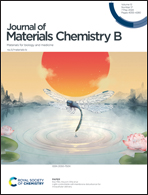Generally applicable circulating tumor cell enrichment and identification through a membrane glycoprotein–targeting strategy combining magnetic isolation and biological orthogonality labeling†
Abstract
Although the importance of circulating tumor cells (CTCs) has been widely recognized, it is still a challenge to realize high-efficiency and accurate enrichment and identification of highly heterogeneous CTCs derived from various types of tumors in complex cancer processes. Currently, the most widely used methods follow the general idea of sequential immunoaffinitive capture and immunostaining to achieve the abovementioned goal. However, different organ/tissue origins as well as the inherent heterogeneity of CTCs would lead to the missed detection of certain CTC subtypes using such methods. Further, immunocytochemistry (ICC) immunostaining disrupts the physiological structure of cells, severely limiting the detection and application scenarios that require the participation of live cells. To address these limitations, we have developed a generally applicable strategy for the isolation and labeling of CTCs. This strategy focuses on targeting the universal characteristics of all tumor cells, specifically the abnormally expressed cell membrane glycoproteins, such as the transferrin receptor and sialic acid. Strategically, transferrin-functionalized magnetic beads (TMBs) were applied to enrich CTCs, and azide-based bioorthogonal chemistry was employed to label target CTCs. Accordingly, the membrane glycoprotein–targeting strategy achieved unbiased enrichment and labeling of broad-spectrum CTCs that were both epithelial and non-epithelial phenotypic populations with varied organ/tissue origins (MCF-7, HepG2, A549, Jurkat, and B16), with a capture efficiency of >95% and a detection limit as low as 5 cells per mL in artificial blood. In particular, our developed strategy displayed excellent specificity, and the CTCs under capture and fluorescence labelling remained with good viability and could be further cultivated and analyzed. Finally, the membrane glycoprotein–targeting strategy successfully detected and identified 33–223 CTCs from 1 mL patient blood samples.



 Please wait while we load your content...
Please wait while we load your content...